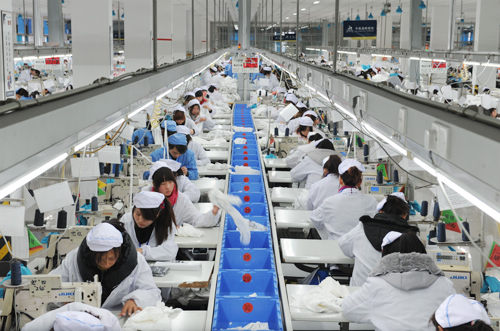|
 |
|
FULL STRENGTH: Staff work at a workshop of Ningbo Seduno Group Co. Ltd. of Zhejiang Province. The privately owned garment company recorded a 18-percent growth in profits in 2011 (HAN CHUANHAO) |

The relationship between China's state-owned enterprises (SOEs) and private companies is questionable at best, with most parties seeing it as oppositional or complementary. Hu Angang, Director of the Center for China Studies at Tsinghua University, shares his views in an article for Journal of the Chinese Academy of Governance, stating that the idea of the state advancing causing the private sector to retreat is a misconception. Edited excerpts follow:
The misconception is this: SOEs and the private sector are playing a zero-sum game. This premise simply supposes that SOEs and the private economy are components under complete market competition. There is no cooperation between the two sectors and one sector's gain results in the other's loss. But in fact, both sectors are important parts of China's socialist market economy, and the relationship between the two is not oppositional, but of mutual promotion and coordinated development.
China's huge economic aggregate and market scale provide wide space for the development and cooperation for SOEs and the private sector. By grasping opportunities and making innovations, both of them can achieve business success. It is the joint development and common prosperity of SOEs and the private sector that ensures China's rapid, steady and sound economic growth. Particularly, in the recent global financial crisis, rapid adjustment made by both SOEs and private companies enabled China to be the first to recover from the turmoil.
Through some figures we can see whether the notion "the state advances and the private sector retreats" is tenable.
According to the National Bureau of Statistics, the number of industrial SOEs whose annual sales revenue is above 5 million yuan ($791,139) (above designated scale) has declined from 64,700 in 1998 to 20,300 in 2010. Among all industrial enterprises above designated scale, the percentage of SOEs declined from 39.22 percent to 4.47 percent. In the same period, the number of private industrial enterprises above designated scale increased from 10,700 in 1998 to 272,300 in 2010, and their percentage among all enterprises above designated scale rose to 60.34 percent from 6.46 percent. Seeing from the number of enterprises, it is not "the state increases and the private sector decreases," but "the state decreases and the private sector increases."
The number of employees in SOEs above designated scale dropped from 37.48 million in 1998 to 18.86 million in 2010, and the percentage of employees in SOEs above designated scale among all industrial enterprises above designated scale dropped from 57.2 percent to 19.2 percent. During the same period, the number of employees in private companies above designated scale expanded from 1.61 million to 33.12 million, and its proportion of the total number of employees in industrial enterprises above designated scale rose from 2.5 percent to 34.7 percent.
The proportion of the aggregate output value of state-owned and state-holding enterprises above designated scale to that of all industrial enterprises above designated scale dropped from 49.6 percent in 1998 to 26.6 percent in 2010. In the same period, the proportion of private companies above designated scale surged from 3.1 percent to 30.5 percent, an increase of nearly 10 fold.
In 2010, state-owned and state-holding enterprises contributed 71.7 percent to the total sales revenue tax paid by industrial enterprises above designated scale, while private companies only contributed 14.6 percent.
| 